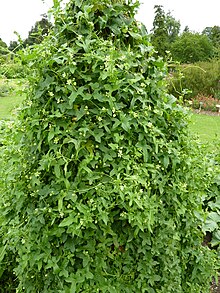Bryonia dioica
| Bryonia dioica | |
|---|---|
 |
|
| Red Bryony (B. dioica) | |
| Scientific classification | |
| Kingdom: | Plantae |
| (unranked): | Angiosperms |
| (unranked): | Eudicots |
| (unranked): | Rosids |
| Order: | Cucurbitales |
| Family: | Cucurbitaceae |
| Subfamily: | Cucurbitoideae |
| Tribe: | Benincaseae |
| Subtribe: | Benincasinae |
| Genus: | Bryonia |
| Species: | B. dioica |
| Binomial name | |
|
Bryonia dioica Jacq. non M.Bieb. non Bojer non Sessé & Moc. |
|
Bryonia dioica, known by the common names red bryony and white bryony, also English mandrake or ladies' seal, is a perennial climbing vine indigenous to Central and Southern Europe. It is a flowering plant in the cucumber family Cucurbitaceae with five-pointed leaves and blue or white flowers. The vine produces a red berry fruit.
B. dioica is generally toxic to humans. Application of its juice to the skin produces inflammation with a rash or ulcers, and consumption of this juice causes intense gastrointestinal irritation including nausea and vomiting in small doses, and anxiety, paralysis, or death in larger amounts.
The seed of this vine, by contrast, is safely edible, and finds use in Western Europe as an ingredient in starch dishes.
The plant is sometimes used in herbalism. In medieval times the plant was thought to be an antidote for leprosy.
The root can be 75 cm (30 in) long and 75 mm (3.0 in) thick. John Gerard's Herball (1597) states that: "The Queen's chief surgeon, Mr. William Godorous, a very curious and learned gentleman, shewed me a root hereof that waied half an hundredweight, and of the bignes of a child of a yeare old."
It can be used fresh at any time of the year. It can also be harvested in the autumn and be dried for later use.
Flowers of Bryonia dioica
...
Wikipedia
